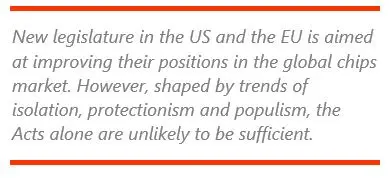Overview
In times of political bloc formations and crisis-related resource shortages, the United States (US) and European Union (EU) see their  role as technology leaders threatened. In 2022, the US and the EU enacted three legislative acts to improve their position in the global chips market. These laws are shaped by trends of isolation, protectionism and populism to strengthen their own market positions. The investments raised by the acts will have a significant impact on various industries. How will the situation on the chips market change because of the laws and what impact will this have on the companies located in the market? This ARC Insight is one of a series on innovations in manufacturing.
role as technology leaders threatened. In 2022, the US and the EU enacted three legislative acts to improve their position in the global chips market. These laws are shaped by trends of isolation, protectionism and populism to strengthen their own market positions. The investments raised by the acts will have a significant impact on various industries. How will the situation on the chips market change because of the laws and what impact will this have on the companies located in the market? This ARC Insight is one of a series on innovations in manufacturing.
Political Background
Global demand for semiconductor chips is expected to double over the next decade, turning semiconductors into a $1 trillion industry. Growth will be driven by an increased demand for integrated circuits used in everyday consumer electronics goods, cars, airplanes or medical devices, and in critical infrastructures such as the energy sector or defense. Above all, they are crucial for the technologies that drive digital transformation, such as artificial intelligence, cloud hosting and networking (5G/6G). While most manufacturers are based in Europe and the US, only about an eighth of the global chips production comes from the US and less than a tenth from the EU. Three-quarters of semiconductors are produced in East Asia, led by Taiwan, which controls well over half the market.
While chip production, especially in the US, has declined in recent years, most manufacturers are located in the West due to the region’s technological leadership. The consequence is a high dependence on East Asian suppliers and fragile supply chains. Since a large semiconductor company relies on many highly specialized suppliers in different countries, crises such as the Covid-19 pandemic or the war between Russia and Ukraine could lead to a shortage, resulting in higher prices and longer delivery times. In addition to automobile production, which declined by a third in Europe since 2020, the healthcare and consumer electronics sectors were also affected. The current shortage is expected to continue for another two years.
Both the US and the EU have perceived how a high level of dependency can lead to shortage crises, and each passed its own chips Act in 2022 to counteract the current trend of declining importance in the field of microchips. The EU wants to double its market share to 20 percent, while the US is aiming for a market share of 30 percent.
Getting Their Acts Together
The European Chips Act (ECA) provides for an investment of around $47 billion, financed by a diversion of existing funds and to a large extent by member states within the framework of the Important Projects of Common European Interest (IPCEI), a European state aid instrument that supports innovative private sector investment projects in member states. In addition to public support, which is to cover 100 percent of the amount necessary for the construction of plants in Europe, private investment is to be stimulated.
With $52.7 billion, the Chips and Science Act (CSA) in the US includes a similar amount of investment that is already fully funded and available, in contrast to the EU, where only $12 billion is fresh money. The Bill includes additional investments for scientific R&D and commercialization, bringing the total to $280 billion by 2030. The CSA is also more extensive in other areas. For example, it offers tax credits of 25 percent on investments in facilities and equipment in the field of semiconductor manufacturing, providing a clear funding framework for the re- and up-skilling of the workforce while integrating the industry more closely into decision-making processes.
In both cases, a large part of the funding amount is earmarked for the construction of plants. While there are no restrictions in the US, so-called “first-of-a-kind” plants are to be financed in the EU. Further, both laws provide for intervention options, such as the coordinating of supply chains in times of crisis, with the ECA referring to economic crises and the CSA referring to the national defense crisis.
ARC Advisory Group clients can view the complete report at the ARC Client Portal.
Please Contact Us if you would like to speak with the author.
Obtain more ARC In-depth Research at Market Analysis






